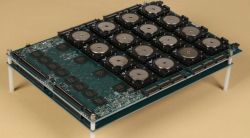DARPA’s SyNAPSE Develops Brain Mimicking 5.4 Billion Transistor Chip

DARPA’s Systems of Neuromorphic Adaptive Plastic Scalable Electronics (SyNAPSE) program has developed a new chip that mimics brain’s power-saving efficiency; uses 100x less power for complex processing than modern chips, DARPA said in a statement.
The SyNAPSE chip is designed by researchers at IBM and is loaded with more than 5 billion transistors and boasts more than 250 million “synapses,” or programmable logic points, analogous to the connections between neurons in the brain.
Many tasks that people and animals perform effortlessly, such as perception and pattern recognition, audio processing and motor control, are difficult for traditional computing architectures to do without consuming a lot of power.
Biological systems consume much less energy than current computers attempting the same tasks. The program was created to speed the development of a brain-inspired chip that could perform difficult perception and control tasks while at the same time achieving significant energy savings.
The chip can be tiled to create large arrays, has one million electronic “neurons” and 256 million electronic synapses between neurons. Built on Samsung Foundry's 28nm process technology, the 5.4 billion transistor chip has one of the highest transistor counts of any chip ever produced.











